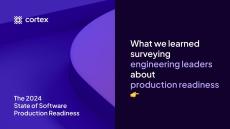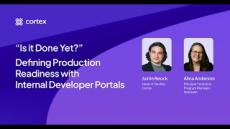|
By Ryan Garrett
Migrating a Kubernetes cluster from a self-hosted environment to Amazon EKS (Elastic Kubernetes Service) offers considerable operational benefits—but this transition also brings challenges in reliability, compliance, and observability. By leveraging Cortex Scorecards, teams gain clear insights and structured benchmarks to simplify and improve the migration process. Here’s how Cortex Scorecards can make your EKS migration efficient and resilient.
|
By Cortex
Is your DevOps security ready for cyber threats? Embrace these best practices and make security your competitive advantage. DevOps, a set of practices that combines software development (Dev) and IT operations (Ops), has revolutionized the way organizations build, deploy, and maintain software. With the rise of cloud computing, there was a need for faster and more reliable software delivery than traditional software development methodologies allowed. DevOps was the natural evolution.
|
By Nikhil Unni
Cortex has received our ISO 27001 certification via Prescient Security. This milestone reinforces our dedication to providing the highest standards of information security for our clients and partners. For engineering leaders and teams who rely on Cortex to streamline development, this certification underscores the trust they can place in us to protect their data at scale.
|
By Cortex
Managing IT infrastructure has traditionally been a complex, manual process prone to inefficiencies and human errors. IaC directly addresses these challenges by automating the setup and management of IT infrastructure through code. This approach helps to resolve common infrastructure management problems like lengthy deployment times, configuration drift, and inconsistent configurations.
|
By Kate Huff
After an incredible week at IDPCon, we're excited to share one of the major announcements we unveiled during the event: the General Availability (GA) of Cortex Workflows with advanced Role-Based Access Controls (RBAC). One of the most highly requested features for Cortex Workflows, advanced RBAC gives you complete control over who can view, edit, and run workflows, supporting enterprises that deal with sensitive operations.
|
By Lauren Craigie
In 2024, there’s no shortage of tools to help engineering teams track team health, productivity, or efficiency. But the problem with those solutions has been two-fold. First, most only track “output” metrics, with no insight into what’s causing teams to ship slower, or resolve fewer incidents. Second, these tools lack flexibility in data inputs and metric definitions, preventing teams from building their own unique measures of excellence.
|
By Lauren Craigie
Engineering teams are always shipping something—new services, resources, models, clusters, etc. You probably have a set of standards you expect developers to abide by when doing that work, like adequate testing, code coverage, resolution of outstanding vulnerabilities, etc. But how are you actually tracking and enforcing those standards? Without an Internal Developer Portal, you might find that to be an incredibly manual effort.
|
By Cortex
This month marks a huge milestone for us at Cortex. We’re excited to announce that ServiceNow, the global leader in digital workflows, has invested in our Series C funding round. Together, we’re pushing forward with our mission to unify tech operations at the enterprise through our industry-leading Internal Developer Portal (IDP).
|
By Lauren Craigie
Let’s be honest: platform engineering is evolving fast, and a lot of teams are being forced to write the rules while still collecting context. Plenty of terms and topics are still up for debate—from, “Is this just DevOps 2.0?” to “How much abstraction is too much?" In this blog we pulled together 10 of the biggest topics being debated today. While we may not have all the answers, we think just getting up to speed on what's left to decide helps all of us get better.
|
By Lauren Craigie
The most time-consuming part of incident resolution is a data problem. Who owns this service? What's it made of? What are the dependencies? Where are the run books? Learn how Cortex cuts incident response time and prevents new issues with up-to-date ownership, reliable runbooks, and Scorecards that drive continuous improvement.
|
By Cortex
The industry is still asking more questions than its answering around #DevEx, Platform Engineering, and even (still!) #DevOps! Hear from Cortex's very own Head of Developer Relations, Justin Reock, get together and talk with other interested minds helps move us more collectively to answers and solutions that can improve the flow, productivity, and ultimately joy of our workforce! Full description.
|
By Cortex
98% of engineering leaders reported at least one major consequence of failing to meet production readiness standards. To better understand how teams are addressing new challenges in production readiness, Cortex recently conducted a survey of engineering leaders at companies with more than 500 employees in North America, Europe, and AsiaPac. The survey included questions pertaining to production readiness standards, tools, struggles, and desired future state.
|
By Cortex
DevOps solutions have evolved quickly over the last few years. Software catalogs have bloomed beyond service registries and runbooks into comprehensive, centralized engineering sources of truth. With ever-expanding developer tool sets, can teams achieve the flexibility needed to address this fragmentation while continuing to tailor software catalog entries to their unique domains and contexts?
|
By Cortex
While we know software projects are never truly “done,” developers will, nevertheless, often face a long list of tasks needed to achieve a certain level of “doneness.” But to what end? And when do they end? When is done—done enough? In this fireside chat-style webinar, Justin Reock - Head of DevRel for Cortex - alongside Alina Anderson - Principal Technical Program Manager at Outreach - will explore an evolved approach to determining production readiness.
|
By Cortex
Lauren Craigie (Head of PMM at Cortex) is joined by Justin Reock, Head of Developer Relations at Cortex for a conversation about meausuring developer productivity.
|
By Cortex
In 2023 most engineering organizations have some way of measuring productivity. Metrics like story points and cycle time help us assess team-wide impact, while code coverage and commits tell us more about individual contributions. While we know these numbers don’t tell the whole story, we rarely hear about how to find the missing pieces. Or what to do next when we learn the culprit is poor testing practices versus bad design. What’s the plan for improvement? Where does it live, and who owns it?
- November 2024 (4)
- October 2024 (5)
- September 2024 (9)
- August 2024 (6)
- July 2024 (6)
- June 2024 (6)
- May 2024 (7)
- April 2024 (7)
- March 2024 (8)
- February 2024 (4)
- January 2024 (8)
- December 2023 (7)
- November 2023 (8)
- October 2023 (10)
- September 2023 (8)
- August 2023 (6)
- July 2023 (3)
- June 2023 (4)
- May 2023 (5)
- April 2023 (3)
- March 2023 (5)
- February 2023 (4)
- January 2023 (5)
- December 2022 (6)
- November 2022 (8)
- October 2022 (8)
- September 2022 (4)
- August 2022 (1)
- May 2022 (2)
- January 2022 (1)
Cortex makes it easy for engineering organizations to gain visibility into their services and deliver high quality software.
Cortex helps engineering teams build better software at scale:
- Align your team and drive accountability: Scorecards enable teams to drive what matters most to them – including service quality, production readiness standards, and migrations.
- A single source of truth for your services: Cortex’s service catalog integrates with the most popular engineering tools, giving teams an easy way to understand everything about their architecture.
- Build a culture of reliability and high performance: Teams enable organizations to drive a sense of ownership and pride as they improve service quality.
- Ensure new services follow best practices from day one: Scaffolder lets developers scaffold a new service in less than five minutes using custom templates crafted by your team.
Cortex gives organizations visibility into the status and quality of their microservices and helps teams drive adoption of best practices so they can deliver higher quality software.





















